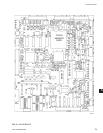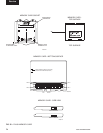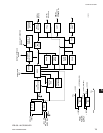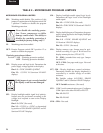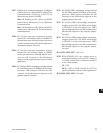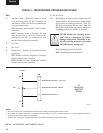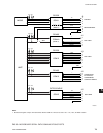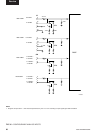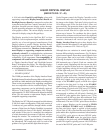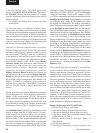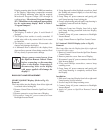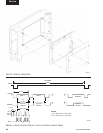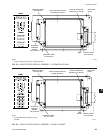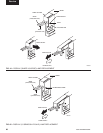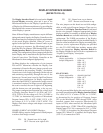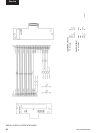
FORM 50.40-OM2
81YORK INTERNATIONAL
LIQUID CRYSTAL DISPLAY
(REFER TO FIG. 37 - 42)
A 10.4 inch color Liquid Crystal Display, along with
supporting components Display Interface Board and
Backlight Inverter Board are mounted on a plate that
is attached to the OptiView Control Center door. A clear
plexiglass faceplate prevents display surface damage.
System operating parameters are displayed on various
color graphic screens. The various display screens are
selected for display using the Keypad keys.
The Display provided in the OptiView RCC or from
YORK as a service replacement part, could be manufac-
tured by any of several approved manufacturers. Each
Display requires a specific Display Interface Board,
Backlight Inverter Board, Inverter Board interface cable
and Program command set. Therefore, Service replace-
ment Displays or supporting components cannot be
arbitrarily selected!!! As explained below, replacement
Displays are provided from YORK as kits to assure
compatibility of all components. Non-compatibility of
components will result in incorrect operation!!! Refer
to “Display Interface Board” and “Backlight Inverter
Board” descriptions that follow. The following displays
could be provided from YORK in new OptiView RCCs
or as replacement parts:
• LG SEMICON LP104V2
• SHARP LQ10D367
The YORK part numbers of the Display Interface Board,
Backlight Inverter Board and Inverter ribbon cable provided,
are listed on a label attached to the Display mounting plate.
These are the part numbers of the supporting components
that are compatible with the installed display. These
supporting components can be individually replaced.
However, if the Liquid Crystal Display fails, Display
replacement kit 331-02053-000 must be ordered as detailed
below. This kit contains a replacement Display and all
compatible supporting components.
The Display has 307,200 pixels arranged in a 640 columns
X 480 rows matrix conguration. Each pixel consists of
3 windows; red, green and blue, through which a variable
amount of light from the Display Backlight is permitted
to pass through the front of the display. Imbedded in
each window of the pixel is a transistor, the conduction
of which determines the amount of light that will pass
through the window. The conduction of each transistor
is controlled by a signal from the Display Controller on
the Microboard. The overall pixel color is a result of the
gradient of red, green and blue light allowed to pass.
Under Program control, the Display Controller on the
Microboard sends a drive signal for each pixel to create
the image on the display. Each pixel’s drive signal is an
18 bit binary word; 6 bits for each of the 3 colors, red
green and blue. The greater the binary value, the greater
the amount of light permitted to pass. The columns of
pixels are driven from left to right and the rows are
driven top to bottom. To coordinate the drive signals
and assure the columns are driven from left to right and
the rows are driven from top to bottom, each drive signal
contains a horizontal and vertical sync signal. The
Display Interface Board receives these display drive
signals from the Microboard J5 and applies them to the
Display at connector CN1. Refer to Fig. 43.
Although there are variations in control signal timing
between different display manufacturers, Fig. 38 depicts
typical control signals. Since these control signals occur
at rates greater than can be read with a Voltmeter, the
following description is for information only. There are
480 horizontal rows of pixels. Each row contains 640
3-window pixels. Beginning with the top row, the drive
signals are applied within each row, sequentially left
to right, beginning with the left most pixel and ending
with the right most pixel. The rows are driven from top
to bottom. The Vertical Sync (VSYNC) pulse starts the
scan in the upper left corner. The rst Horizontal Sync
(HSYNC) pulse initiates the sequential application of
RGB drive signals to the 640 pixels in row 1. Upon
receipt of the ENABLE signal, an RGB drive signal
is applied to the rst pixel. As long as the ENABLE
signal is present, RGB drive signals are then applied to
the remaining 639 pixels at the CLK rate of 25.18MHz,
or one every 39.72 nanoseconds. Typically it takes 31
microseconds to address all 640 pixels. Similarly, the
next HSYNC pulse applies drive signals to row 2. This
continues until all 480 rows have been addressed. Total
elapsed time to address all 480 rows is approximately 16
milliseconds. The next VSYNC pulse causes the above
cycle to repeat. Displays can be operated in FIXED
mode or DISPLAY ENABLE mode. In FIXED mode,
the rst pixel drive signal is applied a xed number
(48) of clock (CLK) cycles from the end of the HSYNC
pulse and the drive signals are terminated a xed number
(16) of CLK cycles prior to the next HSYNC pulse.
In DISPLAY ENABLE mode, the pixel drive signals
are applied to the pixels only while ENABLE signal is
present. This signal is typically present 4-48 CLKS after
the end of the HSYNC pulse and 2-16 CLKS prior
5



